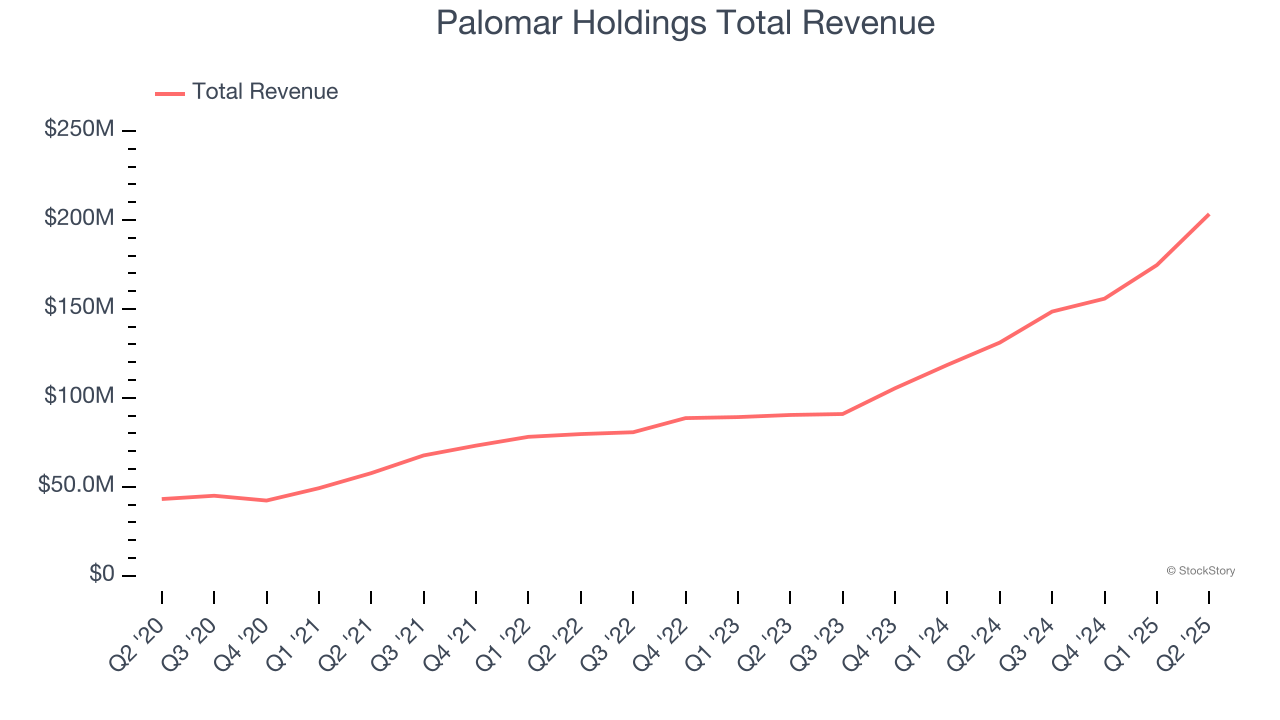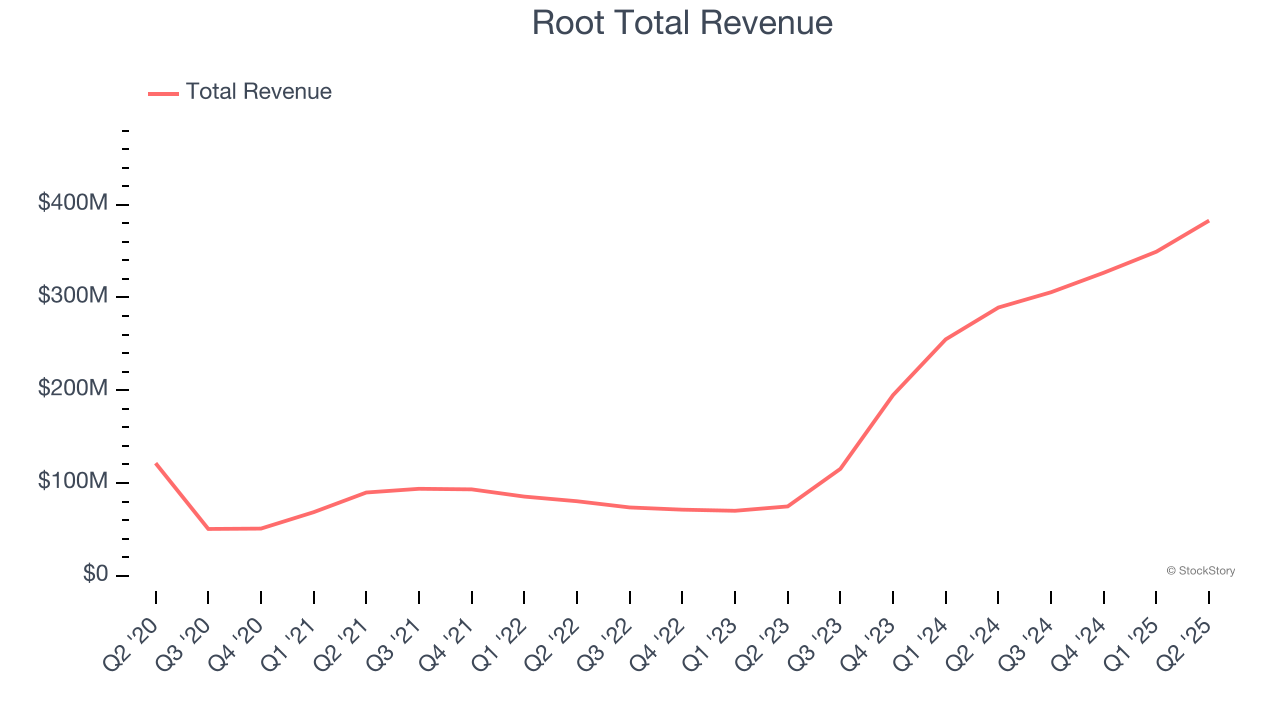
The end of an earnings season can be a great time to discover new stocks and assess how companies are handling the current business environment. Let’s take a look at how Palomar Holdings (NASDAQ:PLMR) and the rest of the property & casualty insurance stocks fared in Q2.
Property & Casualty (P&C) insurers protect individuals and businesses against financial loss from damage to property or from legal liability. This is a cyclical industry, and the sector benefits when there is 'hard market', characterized by strong premium rate increases that outpace loss and cost inflation, resulting in robust underwriting margins. The opposite is true in a 'soft market'. Interest rates also matter, as they determine the yields earned on fixed-income portfolios. On the other hand, P&C insurers face a major secular headwind from the increasing frequency and severity of catastrophe losses due to climate change. Furthermore, the liability side of the business is pressured by 'social inflation'—the trend of rising litigation costs and larger jury awards.
The 33 property & casualty insurance stocks we track reported a satisfactory Q2. As a group, revenues beat analysts’ consensus estimates by 1.5%.
In light of this news, share prices of the companies have held steady as they are up 2.9% on average since the latest earnings results.
Palomar Holdings (NASDAQ:PLMR)
Founded in 2013 to fill gaps in catastrophe insurance markets, Palomar Holdings (NASDAQ:PLMR) is a specialty insurance provider that offers property and casualty insurance products in underserved markets, with a focus on earthquake coverage.
Palomar Holdings reported revenues of $203.3 million, up 55.1% year on year. This print exceeded analysts’ expectations by 9.2%. Overall, it was a strong quarter for the company with an impressive beat of analysts’ net premiums earned estimates.
Mac Armstrong, Chairman and Chief Executive Officer, commented, “Our second quarter results highlight the sustained execution of our Palomar 2X strategic imperative. We achieved strong top and bottom-line growth in the quarter as gross written premium grew 29% across our diverse portfolio and adjusted net income increased 52%. This strong growth underscores the strength of our product set and the efficacy of our balanced book of property and casualty and residential and commercial products. Our financial metrics were equally stout as we generated an adjusted combined ratio of 73%, and a 24% adjusted return on equity.”

Palomar Holdings scored the fastest revenue growth of the whole group. Investor expectations, however, were likely higher than Wall Street’s published projections, leaving some wishing for even better results (analysts’ consensus estimates are those published by big banks and advisory firms, not the investors who make buy and sell decisions). The stock is down 8.6% since reporting and currently trades at $120.53.
Best Q2: Root (NASDAQ:ROOT)
Pioneering a data-driven approach that rewards good driving habits, Root (NASDAQ:ROOT) is a technology-driven auto insurance company that uses mobile apps to acquire customers and data science to price policies based on individual driving behavior.
Root reported revenues of $382.9 million, up 32.4% year on year, outperforming analysts’ expectations by 7.5%. The business had an incredible quarter with a beat of analysts’ EPS estimates and an impressive beat of analysts’ net premiums earned estimates.

Although it had a fine quarter compared its peers, the market seems unhappy with the results as the stock is down 28.1% since reporting. It currently trades at $88.50.
Is now the time to buy Root? Access our full analysis of the earnings results here, it’s free.
Weakest Q2: Selective Insurance Group (NASDAQ:SIGI)
Founded in 1926 during the early days of automobile insurance, Selective Insurance Group (NASDAQ:SIGI) is a property and casualty insurance company that sells commercial, personal, and excess and surplus lines insurance products through independent agents.
Selective Insurance Group reported revenues of $127.9 million, down 89.3% year on year, falling short of analysts’ expectations by 90.3%. It was a disappointing quarter as it posted a significant miss of analysts’ EPS estimates and a significant miss of analysts’ book value per share estimates.
Selective Insurance Group delivered the weakest performance against analyst estimates and slowest revenue growth in the group. As expected, the stock is down 16.2% since the results and currently trades at $75.78.
Read our full analysis of Selective Insurance Group’s results here.
CNA Financial (NYSE:CNA)
With roots dating back to 1853 and majority ownership by Loews Corporation, CNA Financial (NYSE:CNA) is a commercial property and casualty insurance provider offering coverage for businesses, including professional liability, surety bonds, and specialized risk management services.
CNA Financial reported revenues of $3.72 billion, up 5.6% year on year. This number missed analysts’ expectations by 0.8%. Taking a step back, it was still a very strong quarter as it recorded a beat of analysts’ EPS estimates.
The stock is up 7.7% since reporting and currently trades at $47.21.
Read our full, actionable report on CNA Financial here, it’s free.
Allstate (NYSE:ALL)
Born from a Sears, Roebuck & Co. initiative during the Great Depression with its famous "You're in good hands" slogan, Allstate (NYSE:ALL) is one of America's largest personal property and casualty insurers, offering protection for autos, homes, and personal property.
Allstate reported revenues of $16.63 billion, up 6% year on year. This result came in 0.7% below analysts' expectations. Zooming out, it was actually an exceptional quarter as it put up an impressive beat of analysts’ book value per share estimates and a beat of analysts’ EPS estimates.
The stock is up 8% since reporting and currently trades at $207.68.
Read our full, actionable report on Allstate here, it’s free.
Market Update
The Fed’s interest rate hikes throughout 2022 and 2023 have successfully cooled post-pandemic inflation, bringing it closer to the 2% target. Inflationary pressures have eased without tipping the economy into a recession, suggesting a soft landing. This stability, paired with recent rate cuts (0.5% in September 2024 and 0.25% in November 2024), fueled a strong year for the stock market in 2024. The markets surged further after Donald Trump’s presidential victory in November, with major indices reaching record highs in the days following the election. Still, questions remain about the direction of economic policy, as potential tariffs and corporate tax changes add uncertainty for 2025.
Want to invest in winners with rock-solid fundamentals? Check out our 9 Best Market-Beating Stocks and add them to your watchlist. These companies are poised for growth regardless of the political or macroeconomic climate.
StockStory is growing and hiring equity analyst and marketing roles. Are you a 0 to 1 builder passionate about the markets and AI? See the open roles here.
